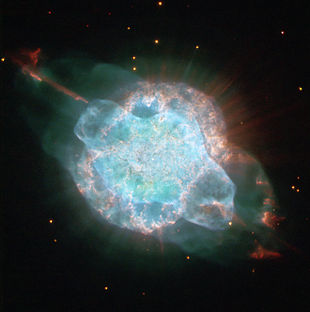NGC 3918
|
Planetary Nebula NGC 3918 |
|
|---|---|

|
|
| An image of the Hubble Telescope from NGC 3918 | |
| AladinLite | |
| Constellation | centaur |
|
Position equinox : J2000.0 |
|
| Right ascension | 11h 50m 17.9s |
| declination | -57 ° 10 ′ 56 ″ |
| Appearance | |
| Apparent brightness (visual) | 8.1 likes |
| Apparent brightness (B-band) | 8.4 mag |
| Angular expansion | 0.38 ′ × 0.38 ′ |
| Central star | |
| Physical data | |
| distance | 4900 ly |
| history | |
| discovery | John Herschel |
| Date of discovery | April 3, 1834 |
| Catalog names | |
| NGC 3918 • PK 294 + 04 1 • ESO 170-PN13 • GC 2581 • PN G294.6 + 04.7 • Hen 2-74 | |
NGC 3918 is a bright planetary nebula in the constellation Centaur . Its distance is about 4,900 light years and it is the brightest of the southern planetary nebulae. NGC 3918 was discovered by John Herschel in March 1834 .
You can find the nebula in the sky with a small telescope. Its slightly oval shape extends over eight to ten minutes of arc .
fluorescence
Characteristic of NGC 3918 is its brilliant blue color. In the center of the object there is a white dwarf . He is the remnant of a red giant and is obscured by the fog. This core emits intense ultraviolet radiation that causes the surrounding fog gas to fluoresce .
dynamics
Spectroscopic data show that the object is moving towards us at around 17 kilometers per second. The nebula itself (its outermost layers of gas) expands at a speed of 97 kilometers per second.
A red giant star emits large amounts of gas in its final phase. This leads to the formation of such planetary nebulae. NGC 3918 shows a brightly glowing inner gas shell and further outside a second, more diffuse gas shell. This gives the impression that these two layers came from two separate discharges. Studies have shown that both layers come from the same eruption. However, the original red giant star blew its various layers of gas away from itself at two different speeds.
The life span of such an object is several tens of thousands of years. Nebulae like NGC 3918 only exist for a relatively short time, as they quickly fade due to the high speed of the fog gas.
Web links
- A Piercing Eye in the Sky - Report from the Hubble site on NGC 391. Retrieved August 5, 2010.
- Planetary Nebula NGC 3918 (English) - NGC 3918 on the Hubble site. Retrieved August 5, 2010.
- Why NGC 3918 appears blue - article by the Astronomical Society of New South Wales. Retrieved August 5, 2010.
- NGC 3918 (English) - NGC 3918 in the SIMBAD Astronomical Database. Retrieved August 5, 2010.
- Blue Planetary (English) - NGC 3918 in the Encyclopedia of Science. Retrieved August 5, 2010.
- astronews.com: Picture of the day